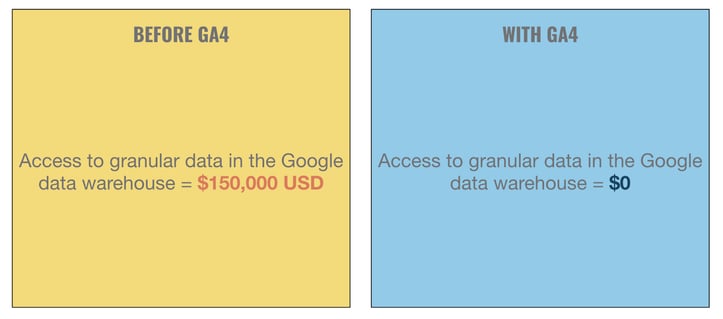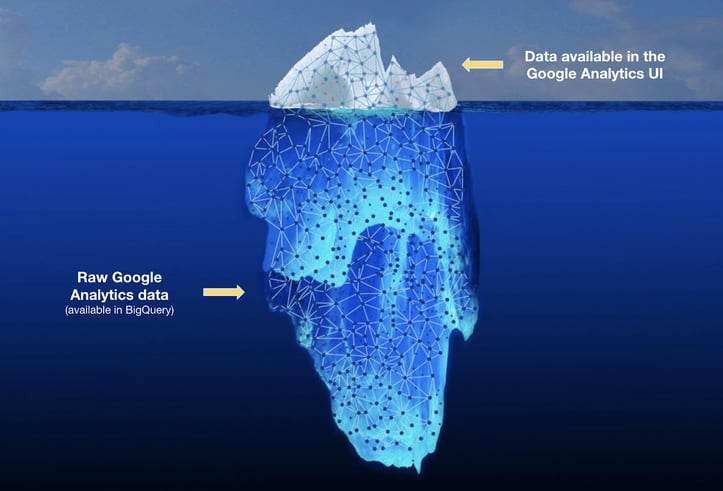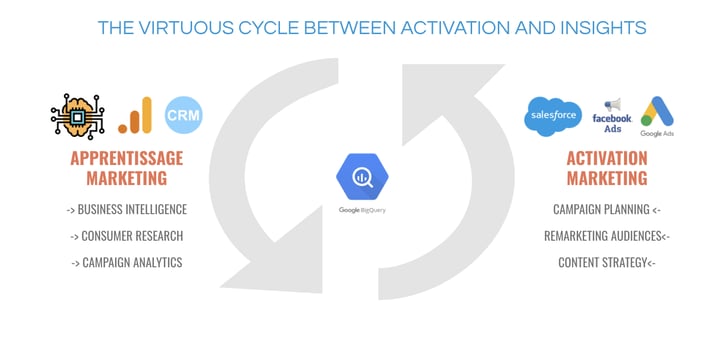Contributor
Why You Should Export Your Google Analytics 4 Data to BigQuery
Contributor
The new version of Google Analytics, commonly referred to as GA4, offers the opportunity to export raw data from the platform towards Google Cloud’s BigQuery. It’s a big decision by Google, given that previously, only customers of the paid version of Google Analytics 360 had access to this functionality. Here’s why marketers should consider this option carefully in 2021.
How to save $150,000 in Google Analytics 360 licensing fees
Other than the fact that it helps prepare you for the seismic changes coming in the world of digital marketing, the major advantage of implementing GA4 is that it provides you with the opportunity to export your raw data – FREE – from Google Analytics to Google Cloud’s BigQuery data warehouse. The goldmine represented by having access to raw analytics data is one of the main reasons many large companies decided to procure GA 360 licenses in the first place.
As mentioned in our earlier article on GA4, this represents a massive savings and opens up access to the cloud to companies of all sizes.
The calculation is simple:

Why make the leap from Google Analytics to BigQuery?
For many digital marketers, the idea of sending your analytics data to the cloud can seem Dantean, on top of which, for many companies, the GA reporting interface is comfortable, a known entity. In spite of its faults, Google Analytics has long been the most popular tool for analyzing the performance of digital ad campaigns, email, and for monitoring and evaluating the results of organic visits, purchase behaviour, etc.
You are probably asking yourself why you would change analytics tools when you already have all the data you need in the GA interface. Well, at the risk of offending, it’s because your perception of the situation is wrong.
Essentially, the data in the interface is actually just an infinitesimal portion of the full marketing analytics potential at your disposal. Consequently, the majority of Google Analytics users have only seen and explored the tip of an enormous iceberg, most of which is still submerged.

5 benefits of exporting raw data to BigQuery
You might now be asking yourself, what can you do with all this extra data?
Here are five reasons your company should start exporting its raw GA4 data to the BigQuery warehouse:
- Unifying your Google Analytics data with your ad data (beyond Google Ads), as well as your offline and CRM data can allow you to analyze and understand the real customer journey and life-cycle of your customers and users at a granular level;
- When you own your raw digital data it’s easier to acquire new customers and take advantage of greater control over the analysis and creation of remarketing segments and personalization using first-party data (to then send it back to third-party ad platforms or a CDP – Customer Data Platform);
- Develop the capacity to obtain data in real time using other cloud-based tools like Pub/Sub, in order to better orchestrate your marketing offensives at key times of the year (Black Friday, for example) when every moment counts;
- Carry out more in-depth analyses of your content and customers’ average shopping cart size to optimize your upsell and cross-sell campaigns, thus maximizing the value of each customer;
- Prepare your data for predictive analytics to better predict consumer demand or even increase your customer retention rate by more rapidly and effectively capturing signals of attrition;
In the end, all these activities in BigQuery fulfill three major business goals for your marketing team:
- More efficient customer acquisition (better CAC or CPA)
- More efficient increase in average cart size (better LTV)
- More controlled customer attrition (better retention)
And all of it… Faster!
Currently, your standard Google Analytics account isn’t equipped to adequately satisfy these objectives or, at least, not for all your marketing initiatives. However, with access to more in-depth data, it makes sense that you would be able to go further.
BigQuery is an expressway to augmented analytics and artificial intelligence
Another benefit of making the transition to GA4 right away (while keeping your current Google Analytics account active) is that by exporting your data to the Google Cloud environment, you will smooth your transition to the emerging world of augmented analytics and artificial intelligence as applied to marketing and e-commerce.
Even if you don’t have access to a data scientist on your team or your agency’s, BigQuery offers machine learning models that are relatively easy to build using the Google Analytics data you’ve imported into the Cloud. These models are available in SQL (Structured Query Language), which makes them much more accessible to a data analyst who’s less familiar with models designed in programming languages like R or Python.
Naturally, for those who can rely on the expertise of data scientists, it’s possible to go even further and really push your marketing data to the next level with libraries like Tensorflow or PyTorch.
Facilitating access to your data accelerates decision-making
We all know the expression “time is money.” In an increasingly digital world, these words are truer than ever.
Waiting weeks or months before acting on a one-time business or marketing situation can cost your company millions of dollars, especially in a volatile economy.
How will you respond to a pandemic, a new industry trend or even an aggressive offer from a new competitor in your space? Being able to count on the right data at the right time is no longer a luxury enjoyed only by big corporations. It’s now a question of survival for companies of all sizes.
For those who were already using a traditional data warehouse, but who were constantly battling with IT to export any sort of moderately interesting analyses, another benefit of BigQuery is that it can greatly accelerate and simplify this often laborious process. Imagine accessing a report in just a few minutes that normally takes days or weeks to extract from a traditional database or warehouse.
What’s more, if you need to cross sensitive data from your traditional data warehouse with the marketing data in BigQuery, Google Cloud has a service called DLP (Data Loss Prevention). This service will allow you to import sensitive data into BigQuery while making it anonymous, a function that’s very popular among IT security teams 🤓.
In a sense, a cloud-based data warehouse brings to your marketing data what tag manager brought to the integration of your Google Ads, Facebook Ads and programmatic conversion pixels: it allows you to reduce the number of interventions needed and take action more rapidly.
That said, the idea isn’t to replace your traditional data warehouse if you have one, but to create a separate, complementary instance that will be more agile and better adapted to the needs of marketing. If, however, your company wasn’t already using a data warehouse, this is the ideal opportunity to build one, and do it right 😉.
It’s time for marketers in Quebec and Canada to reach the next level in analytics
According to a BDC study, barely 19% of Canadian companies are considered mature when it comes to digital transformation and data exploitation. This percentage is very low, even worrying.
In an era of great uncertainty, data is our best compass. We can no longer focus the entirety of our marketing investments on campaign activation in 2021. We need to find a balance and invest a greater proportion of our marketing budgets into the exploitation of the data itself, especially in our many activation platforms (advertising, CRO, personalization, email, etc.). It’s essential to understand that the amount of time you spend on learning or producing insights from your activation campaigns is just as important as the marketing activation itself, if not more.
Essentially, neglecting the exploitation of your activation data equates to neglecting your marketing strategy. The two are interdependent and inseparable.

In addition, remember that the upcoming 2022 cookie apocalypse makes it even more urgent to properly manage your marketing data. By extension, equipping your marketing platforms, including Google Analytics, with richer data would be a smart way to enhance your analytics roadmap for 2021. Moreover, if you’ve implemented a functional instance of GA4, it will cost you $150,000 US less to get there, thanks to BigQuery.
*
For anyone who wants to explore the idea of marketing data warehouses and data lakes in greater depth, I published an article in the Journal of Applied Marketing Analytics, a peer-reviewed academic and trade publication based out of London, describing a model for data lake or warehouse architecture adapted to marketing. You can download a courtesy copy of the article using the following link: AMA article.
For any other question on how you can integrate GA4 and BigQuery into your 2021 roadmap, don’t hesitate to communicate with the experts on our analytics and data science team.

-1.png)

-1.png)




